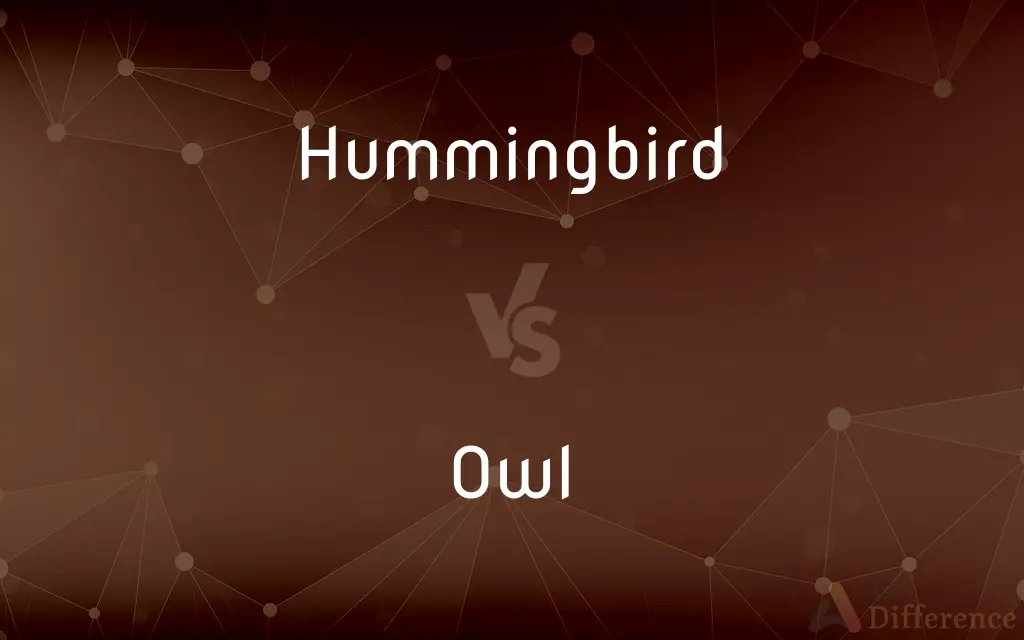Hummingbird vs. Owl — What's the Difference?
By Maham Liaqat & Urooj Arif — Updated on April 2, 2024
Hummingbirds are tiny, vibrantly colored birds known for hovering and backward flight, feeding primarily on nectar, while owls are larger, nocturnal birds of prey, recognized for their silent flight and carnivorous diet.

Difference Between Hummingbird and Owl
Table of Contents
ADVERTISEMENT
Key Differences
Hummingbirds, characterized by their diminutive size and iridescent colors, excel in rapid wing flapping, enabling them to hover in place while feeding on nectar from flowers. This ability is facilitated by their unique wing structure. Owls, on the other hand, possess a much larger body size and a muted color palette, designed for stealth and camouflage. Their silent flight is attributed to specialized feathers that minimize noise, allowing them to approach prey unnoticed.
While hummingbirds are diurnal, thriving in daylight to exploit the visual allure of flowers, owls are predominantly nocturnal or crepuscular, adapted to hunting in low light conditions. This difference underscores the varying ecological niches and survival strategies of these birds. Owls' enhanced night vision and acute hearing are critical for locating prey in the dark, contrasting sharply with hummingbirds' reliance on visual cues and speed.
The diet of hummingbirds is mainly composed of nectar, supplemented by insects and spiders for protein. This diet reflects their role as pollinators, inadvertently transferring pollen as they feed from flower to flower. Conversely, owls are obligate carnivores, preying on a variety of animals from insects to small mammals, indicative of their position as apex predators in their respective ecosystems.
Reproductive strategies also vary significantly between the two. Hummingbirds lay very small eggs, usually only one to three per clutch, and their nests are tiny, crafted with delicate materials like spider silk. In contrast, owls lay larger eggs in sparser clutches and often reuse nests or take over other birds' nests, reflecting a less energy-intensive approach to nest building.
In terms of migration, many hummingbird species undertake long-distance migrations to exploit seasonal abundance of food, showcasing remarkable endurance. Owls, however, are generally more sedentary, with some species showing territorial behavior, highlighting a difference in adaptation to their food resources and habitats.
ADVERTISEMENT
Comparison Chart
Size and Color
Small, vibrant colors
Larger, muted colors
Flight
Capable of hovering and backward flight
Silent flight
Activity Time
Diurnal
Nocturnal/Crepuscular
Diet
Nectar, insects, spiders
Carnivores (insects to small mammals)
Reproduction
Small eggs, tiny nests
Larger eggs, reuses nests
Migration
Long-distance migrants
Mostly sedentary, territorial
Sensory Adaptation
Relies on visual cues
Enhanced night vision and hearing
Compare with Definitions
Hummingbird
Tiny birds known for their ability to hover.
A hummingbird hovered beside the red flower, flapping its wings rapidly.
Owl
Nocturnal birds of prey.
The owl hunted silently under the cover of night.
Hummingbird
Feeds primarily on nectar.
The garden's hummingbirds feed on the nectar from the blooming flowers.
Owl
Territorial behavior.
The owl has been known to aggressively defend its territory from intruders.
Hummingbird
Vibrant plumage.
The hummingbird's vibrant plumage shimmered in the sunlight.
Owl
Carnivorous diet.
Owls feed on a diet consisting mostly of small mammals and insects.
Hummingbird
Rapid wing movement.
The rapid wing movement of the hummingbird allows it to remain stationary in air.
Owl
Silent flight.
The owl's silent flight enables it to sneak up on prey.
Hummingbird
Long-distance migrants.
Some hummingbirds are long-distance migrants, traveling thousands of miles each year.
Owl
Muted coloration for camouflage.
The owl's muted coloration helps it blend into the tree bark.
Hummingbird
Hummingbirds are birds native to the Americas and comprise the biological family Trochilidae. With about 360 species, they occur from Alaska to Tierra del Fuego, but the vast majority of the species is found in the tropics.
Owl
Owls are birds from the order Strigiformes , which includes over 200 species of mostly solitary and nocturnal birds of prey typified by an upright stance, a large, broad head, binocular vision, binaural hearing, sharp talons, and feathers adapted for silent flight. Exceptions include the diurnal northern hawk-owl and the gregarious burrowing owl.
Hummingbird
Any of numerous birds of the family Trochilidae found throughout the Americas, usually very small in size and having brilliant iridescent plumage, a long slender bill, and wings capable of beating very rapidly, thereby enabling the bird to hover.
Owl
Any of various often nocturnal birds of prey of the order Strigiformes, having hooked and feathered talons, a large head with a short hooked beak, large eyes set forward, and fluffy plumage that allows for almost noiseless flight.
Hummingbird
Any of various small American birds in the family Trochilidae that have the ability to hover.
Owl
Any of several breeds of domestic pigeons having a very short beak somewhat like that of an owl and often a frill of feathers on the chest.
Hummingbird
Any bird of the family Trochilidæ, of which over one hundred genera are known, including about four hundred species. They are found only in America and are most abundant in the tropics. They are mostly of very small size with long slender bills adapted to sucking nectar from flowers, and are noted for the very brilliant iridescent colors of their plumage and their peculiar habit of hovering about flowers while vibrating their wings very rapidly with a humming noise; the wings are specialized for hovering flight, but they can also dart forward and fly quite rapidly. They feed both upon the nectar of flowers and upon small insects. The common humming bird or ruby-throat of the Eastern United States is Trochilus colubris. Several other species are found in the Western United States. See Calliope, and Ruby-throat.
Owl
Any of various birds of prey of the order Strigiformes that are primarily nocturnal and have forward-looking, binocular vision, limited eye movement, and good hearing.
Hummingbird
Tiny American bird having brilliant iridescent plumage and long slender bills; wings are specialized for vibrating flight
Owl
(by extension) A person seen as having owl-like characteristics, especially appearing wise or serious, or being nocturnally active.
Owl
An owl pigeon.
Owl
A politician with moderate views that are neither hawkish nor dovish.
Owl
Any of various nymphalid butterflies, especially in the genus Caligo, having large eyespots on the wings.
Owl
To smuggle contraband goods.
Owl
Any species of raptorial birds of the family Strigidæ. They have large eyes and ears, and a conspicuous circle of feathers around each eye. They are mostly nocturnal in their habits.
Owl
A variety of the domestic pigeon.
Owl
To pry about; to prowl.
Owl
To carry wool or sheep out of England.
Owl
Hence, to carry on any contraband trade.
Owl
Nocturnal bird of prey with hawk-like beak and claws and large head with front-facing eyes
Common Curiosities
Do hummingbirds participate in migration?
Many hummingbird species undertake long-distance migrations to follow seasonal food sources.
Can owls fly silently?
Yes, owls can fly silently thanks to their specialized feather structure.
What enables hummingbirds to hover?
Hummingbirds can hover due to their unique wing structure and rapid wing flaps.
How do hummingbirds and owls differ in diet?
Hummingbirds primarily consume nectar, while owls are carnivorous, preying on a range of animals.
What is the main food source for hummingbirds?
The main food source for hummingbirds is nectar, though they also eat insects and spiders.
How do owls hunt their prey?
Owls hunt by using their enhanced night vision and silent flight to surprise prey.
What adaptations do hummingbirds have for feeding?
Hummingbirds have long, slender beaks and tongues designed for extracting nectar from flowers.
What types of habitats do owls prefer?
Owls inhabit a variety of habitats, from forests and deserts to urban areas.
Are all owls nocturnal?
While most owls are nocturnal, some species are crepuscular, active at dawn and dusk.
How do hummingbirds contribute to the environment?
Hummingbirds are important pollinators, transferring pollen between flowers as they feed.
Can hummingbirds fly backwards?
Yes, hummingbirds are one of the few bird species capable of flying backwards.
How do hummingbirds and owls reproduce?
Hummingbirds lay very small eggs in tiny nests, while owls lay larger eggs and often reuse nests.
Are owls found worldwide?
Owls are found in nearly every part of the world, from the Arctic to the tropics.
How do hummingbirds maintain their energy levels?
Hummingbirds consume a high-energy diet of nectar and insects to support their rapid wing movement and metabolic rate.
Do owls have predators?
Owls are apex predators, but they can be preyed upon by larger owls and eagles.
Share Your Discovery

Previous Comparison
Grease vs. Oil
Next Comparison
Colt vs. FoleAuthor Spotlight
Written by
Maham LiaqatCo-written by
Urooj ArifUrooj is a skilled content writer at Ask Difference, known for her exceptional ability to simplify complex topics into engaging and informative content. With a passion for research and a flair for clear, concise writing, she consistently delivers articles that resonate with our diverse audience.
















































